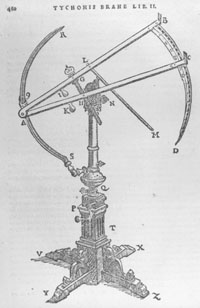Tycho Brahe's Books
Some historians have made strong claims about the role of the printing-press in the transformation of the sciences during the Renaissance, and Tycho Brahe, as an astronomer who controlled his own printing-press, has attracted particular attention. But Tycho was not the first astronomer-printer. Moreover, his printing operation was not run as a commercial enterprise. Although he produced his own works in large print-runs, only a few copies, presented as gifts to princes, nobles, and fellow scholars, were distributed in his lifetime. These gift-copies were sometimes furnished with lavish bindings and hand-coloured illustrations. Tycho also presented copies of works in manuscript. A sextant from one of Tycho's books.
A sextant from one of Tycho's books.
Tycho's first work, De Nova Stella (1573), was printed in Copenhagen. It was after he had moved to Hven that he acquired his own press, which was operational by 1584. Poems and works under the name of his students were issued from the press; Tycho also offered to print texts for his friends and correspondents, but was prevented from doing so by a shortage of paper. This problem, which also held up the printing of his own works, eventually caused Tycho to construct a paper-mill on Hven. The De mundi aetherei recentioribus phaenomenis (1588) and the Epistolae astronomicae (1596) were both produced at Uraniborg, while the Astronomiae instauratae mechanica (1598) and the Astronomiae instauratae progymnasmata (1602) were begun there, but completed after Tycho had left Denmark.
Tycho had planned to produce an account of his instruments for some years prior to the completion of the Astronomiae instauratae mechanica, and woodcuts which were destined for this work can also be found in his other publications; the image shown here, of one of Tycho's sextants, was first printed in 1588. In describing the construction and use of astronomical instruments, Tycho was following in a tradition which included Ptolemy, the Alfonsine astronomers, and Regiomontanus. However, in the level of detail he provided, and in the standard of his illustrations, he appears to have established a precedent which influenced many later astronomers.